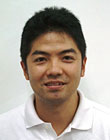Top>Research>Nano complex laminated film for storing energy
 Index
Index
Nano complex laminated film for storing energy
Hiroaki Ozawa
Assistant Professor, Faculty of Science and Engineering, Chuo University
Areas of Specialization: Complex Chemistry, Carbon Chemistry, Molecular Electronics
1.Storing energy
When you hear the term "energy device," what comes to mind? This term may be unfamiliar to people who are not experts in the field. Energy device is a general term for lead storage batteries and NiCad batteries. More recently, it also includes devices such as fuel cells and lithium-ion secondary batteries. All of these devices are used in daily life. Those of you with knowledge of cars may be familiar with the energy regeneration device which converts a portion of the kinetic energy during braking into electric energy. This is also a type of energy device. In recent years, research for the use of renewable energy through solar power and wind power is being conducted throughout the world. However, there are still many unresolved issues such as the influence of natural conditions such as weather. Therefore, in addition to simply creating electricity, storage devices are important for realizing efficient use of that energy. Of course, energy devices are also an important part of daily life. In fact, they have become an essential part of our lives and are used as the batteries of mobile phones, computers, and other electronics.
2.Electric double-layer capacitor as an energy device
Generally speaking, devices which store energy can be divided into batteries and capacitors. Batteries used in mobile phones and computers convert electric energy into chemical energy for storage. The main characteristic of this method is the ability to withdraw stable energy over a long period of time. On the other hand, capacitors, which are energy devices with uses such as the energy regeneration system of cars, store electricity without conversion. This makes it possible to instantaneously withdraw a large amount of energy. Among such energy devices, we are focusing our research on electric double-layer capacitors and super capacitors. To begin with, I will explain the principles through which electric double-layer capacitors store electricity. Unlike devices such as conventional electrolytic capacitors, electric double-layer capacitors do not possess a dielectric. Rather, they utilize a condition known as “electric double-layer,” which is formed by an array of positively and negatively charged particles on the interface of electrodes and electrolytes. The principle for storing electricity is quite simply. During charging, electricity is stored by aligning ions and electric charges on the electrode interface when exerting electric potential between the two electrodes which sandwich the electrolyte (Figure 1, left). During the discharge of electricity, the ions inside of the solution return to the solution from the electric double-layer when the charge is removed.
One factor which decides the characteristics of an electric double-layer capacitor is the electrode surface area. When there is a large number of ions stored on the electrode surface, more electricity can be stored and used as energy. Therefore, there is demand for the development of electrode structures which can store more electricity with greater stability and efficiency.
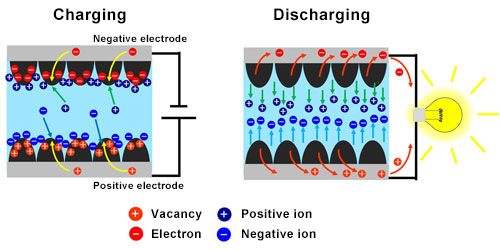
Figure 1 Electricity storage principle of electric double-layer capacitors; condition of ions and electric charges during charging (left) and discharging (right)
3.Complex laminated film used in our research
We have focused our research on methods for constructing nano-laminated structures by sequentially laminating molecular units as a method for modifying hard surfaces. We noticed that it is possible to manufacture redox-type electric double-layer capacitors by incorporating redox-active substances into this nano-laminated structure. We then examined the characteristics of such capacitors. The molecule which we synthesized is a ruthenium binuclear complex composed of an organic ligand and two ruthenium ions (the structure is shown in Figure 2). Although this appears to be complicated at first glance, the structure possesses eight phosphonic acid groups on the top and bottom. These phosphonic acid groups make it possible to bond with metal ions and oxide surfaces. In order to produce laminated film, we start by soaking a conductive transparent substrate called ITO (indium tin oxide) in a solution made by dissolving a complex. As a result, the first layer of complex film is formed by four phosphonic acid groups. Next, we soak the same substrate in a solution including zirconium ions. This causes the top four phosphonic acid groups in the complex film on top of the substrate to bond with the zirconium ions. Next, we soak the substrate again in the complex solution, thus bonding the next complex on top of the zirconium ions and forming the second layer of complex film. In this way, we produce a laminated film with structure controlled on the molecular level by alternately soaking the substrate in a complex solution and a zirconium ion solution (Figure 3). This method of producing laminated film is called the “layer-by-layer self-assembly.” Through this method, it is possible to create a laminated film structure with the desired number of layers simply by repeating process of alternately soaking the substrate in a complex solution and a zirconium ion solution. No special equipment or technology is required.
Upon investigating the dependence on number of layers for the redox activity of the ruthenium complex which is the structural unit of the laminated film created on the substrate, we found that increasing the number of layers causes the amount of electrical charge to increase in a straight line. This means that it is possible for all complex layers of the laminated film to retain electrochemical activity. Furthermore, EQCM (Electrochemical Quartz Crystal Microbalance) measurement revealed that it is possible to pull ions inside of the laminated film via the redox reaction. In other words, we found that the laminated film contains numerous vacancies which can store a large number of ions (electric charges) through oxidation (Figure 4). Stated simply, this material has the potential to show outstanding redox capacitor characteristics which make it possible to store a large amount of electricity.
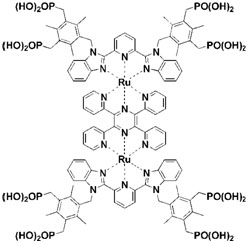
Figure 2 Chemical structure of a ruthenium binuclear complex which possesses phosphonic acid anchor groups on both ends
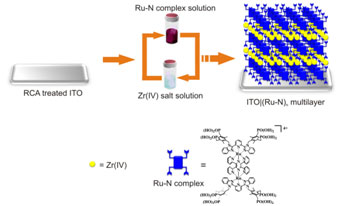
Figure 3 Method for producing complex laminated layers on an ITO substrate. A laminated film is produced by alternatively soaking the ITO substrate in a complex solution and a zirconium solution.
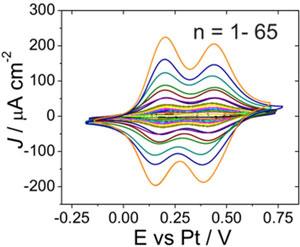
Figure 4 Change in the cyclic voltammogram of a complex laminated film when increasing the number of laminated complex layers from 1 to 65.
4.Application to energy devices
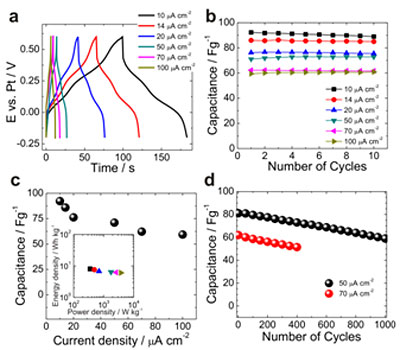
Figure 5
(a) Constant current charge/discharge measurement using a complex laminated film with 65 layers
(b) Relationship between repeated measurement and capacitance when changing the electric current value
(c) Relationship between electric current density and capacitance; inserted figure is a ragone plot
(d) Device stability during repeated measurement at an electric current density of 50 and 70 uA cm-2
Our team conducted joint research with Professor Katharina M. Fromm of the University of Fribourg in order to examine whether the laminated film which we produced will function as a capacitor. First, in order to investigate how much electricity (ions and electric charges) can be stored by a device laminated with 65 layers of complexes, we conducted charge/discharge measurement at constant current as an electrochemical measurement method. Figure 5a shows the results for charge/discharge characteristics when changing the electric current value to 10-100 uA cm-2. Sudden increase/decrease can be seen in each curve around 0.12 V and 0.37 V. The values coincide almost exactly with the redox potential of the ruthenium complex inside the laminated film which was obtained from the voltammogram in Figure 4. This indicates that ions are being acquired during the charging process and being released during the discharging process caused by oxidation of ruthenium inside of the complex film. The maximum capacity of this laminated film device is 92.2 F・g-1 (10 uA cm-2), while the minimum capacity is 63.3 F・g-1 (100 uA cm-2). This difference is caused due to a limit for the movement speed of ions. The storage capacity differs by 35% depending on the speed of ions. When comparing our device to conventional capacitors, we found that it shows fast charging/discharging and is capable of storing a large electric charge. We also verified that there is little deterioration in relation to repeated charging/discharging when changing the electric current value. Next, we created a ragone plot (Figure 5c), which is also used to evaluate the performance of batteries. For our laminated film device, in a range of 0.9 V, energy density and output density were about up to about 3736 W kg-1 and 6 W h kg-1, respectively. It is clear that our device possesses characteristics which are equivalent or superior to conventionally-used capacitors. Finally, we conducted repeated charging/discharging experiments. Even when repeating both charging and discharging 1,000 times at a constant current of 50 uA cm-2, we found that our device maintains at least 70% of performance (Figure 5d).
5.Conclusion

Figure 6 Featured on the back cover of Nanoscale, a journal of the Royal Society of Chemistry
By connecting zirconium ions with redox activation complex units, our team constructed an inorganic-organic nano-network film which possesses a laminated structure. We verified that, in conjunction with redox, it is possible to store a large number of ions inside this laminated film structure. Furthermore, the structure is superior to conventional capacitors and works efficiently as an energy device. However, there are still numerous issues which have yet to be solved. For example, creating the electrodes is a time-consuming process, and the use of the precious metal ruthenium results in a high price. However, we succeeded in creating a complex molecular film which features precise nano-level structural control and which works as a redox capacitor. This has the potential to contribution to the solution of energy issues. Moving forward, we will actively conduct research in order to help resolve energy issues through our “substance creation chemistry.” Our research results were featured on the back cover of Nanoscale, a journal of the Royal Society of Chemistry (Figure 6). On a closing note, these results were realized through joint research with a group led by Professor Thomas Wandlowski of the University of Bern (Switzerland) and a group led by Professor Katharina M. Fromm of the University of Fribourg. I would like to thank everyone involved.
Reference Literature
- Masaaki Haga, Hiroaki Ozawa “A Big World Seen From the Nano-Scale & Micro-Scale” (edited and written by Hitoshi Shindo), Chapter 12, pp. 223-242, 2013 (Chuo University Press)
- Hiroaki Ozawa
Assistant Professor, Faculty of Science and Engineering, Chuo University
Areas of Specialization: Complex Chemistry, Carbon Chemistry, Molecular Electronics - Hiroaki Ozawa was born in Ehime Prefecture in 1979. He graduated from the Faculty of Science, Ehime University in 2002, and from the Graduate School of Science and Engineering, Ehime University in 2004. He completed the Master's Program (Science) at the School of Physical Science, SOKENDAI, the Graduate University for Advanced Studies. He served as a Research Associate at Nagoya University, Research Associate (Specially-Appointed Assistant Professor) at Kyushu University, and a member of Research Fellowship for Young Scientists at the Japan Society for the Promotion of Science at the National Institute for Materials Science (NIMS). He assumed his current position in 2012. He is currently conducting research for fusing functional inorganic complexes with nano-carbon material, with the goal of developing nano-devices based on new concepts and energy devices which will be useful in daily life.
- Research Activities as a Member of Research Fellowship for Young Scientists (DC1), Japan Society for the Promotion of Science (JSPS) Shuma Tsurumi
- Important Factors for Innovation in Payment Services Nobuhiko Sugiura
- Beyond the Concepts of Fellow Citizens and Foreigners— To Achieve SDGs Goal 10 “Reduce Inequality Within and Among Countries” Rika Lee
- Diary of Struggles in Cambodia Fumie Fukuoka
- How Can We Measure Learning Ability?
—Analysis of a Competency Self-Assessment Questionnaire— Yu Saito / Yoko Neha - The Making of the Movie Kirakira Megane








